Asturias, one big nature reserve
Wednesday, March 25, 2020
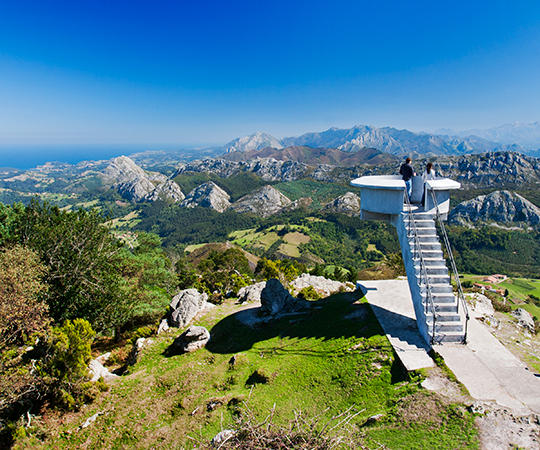 One thing Asturians are proud of is their region's nature: its mysterious forests and coastline left unscathed by the whirlwind of property developments, its salmon rivers and steep mountains, ideal for rock climbers and hikers. Arising from this pride is a magnificent conservation that has led to more than a third of Asturias' territory being declared as national and international protected areas and the best-preserved coastline in Spain. One thing Asturians are proud of is their region's nature: its mysterious forests and coastline left unscathed by the whirlwind of property developments, its salmon rivers and steep mountains, ideal for rock climbers and hikers. Arising from this pride is a magnificent conservation that has led to more than a third of Asturias' territory being declared as national and international protected areas and the best-preserved coastline in Spain.
The exploration begins with the 6 UNESCO-listed Biosphere Reserves in the Principality.
The Picos de Europa's reserve was Spain's first National Park, protected since 1918. Rising up in the centre of this park is the Picu Urriellu, a real magnet for rock climbers, which then opens onto the Lakes of Covadonga. Fuentes del Narcea, Degaña and Ibias is a Nature Park with totemic fauna including the brown bear and capercaillie. Within this park you will also find the Muniellos Forest Nature Reserve and El Cueto de Arbás Partial Nature Reserve.
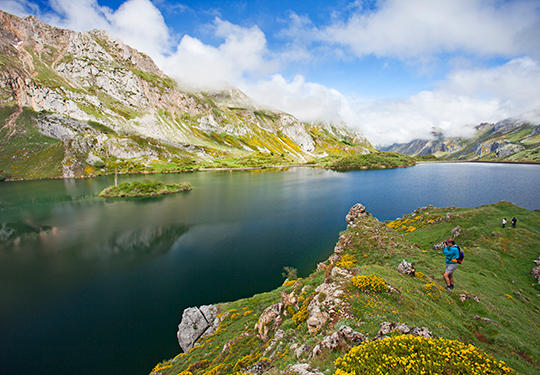
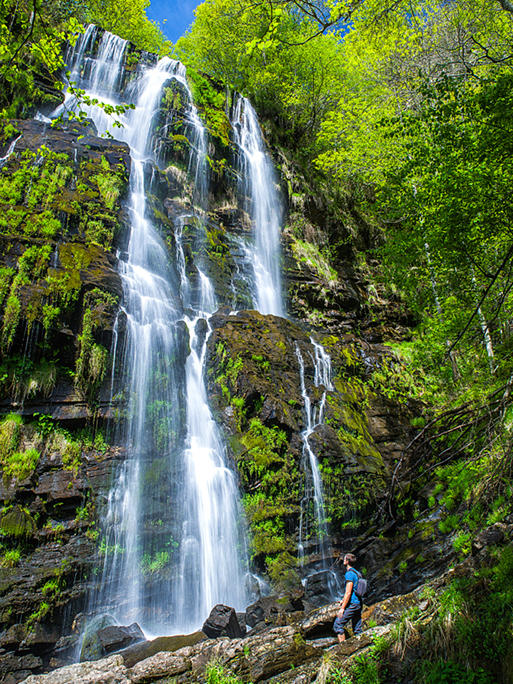
Only 20 people per day can enjoy the experience of travelling through the Muniellos Forest, the largest oak grove in Spain and one of the best-preserved in Europe. You need to book far enough in advance. The route is mapped out, is circular and is 20 kilometres long. It's free but you can pay for a guide. It takes about seven hours and covers an ascent of 600 m.
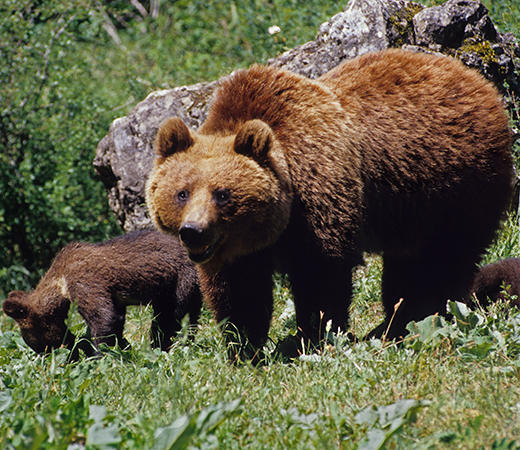 The brown bear's habitat extends up to Somiedo which, as well as being a Biosphere Reserve, became the first Nature Park in Asturias (1988). Its lake, El Valle, is the biggest in the region and its brañas (high-mountain pasture areas) are dotted with teitos (thatched roof cottages). Las Ubiñas - La Mesa Nature Park contains the second largest mountain range in the region, the Peña Ubiña Massif and is full of natural monuments, such as the Huerta Cave, home to a large bat hibernation colony, or the Puertos de Marabio, with its peculiar karst complex. Redes is a refuge for all species native to northern regions, from the brown bear to the capercaillie or the wolf. Its complex terrain, also recognised as a Nature Park, is combined with spectacular mountains, valleys and limestone gorges that can be discovered on the River Alba Trail or in Los Arrudos. The brown bear's habitat extends up to Somiedo which, as well as being a Biosphere Reserve, became the first Nature Park in Asturias (1988). Its lake, El Valle, is the biggest in the region and its brañas (high-mountain pasture areas) are dotted with teitos (thatched roof cottages). Las Ubiñas - La Mesa Nature Park contains the second largest mountain range in the region, the Peña Ubiña Massif and is full of natural monuments, such as the Huerta Cave, home to a large bat hibernation colony, or the Puertos de Marabio, with its peculiar karst complex. Redes is a refuge for all species native to northern regions, from the brown bear to the capercaillie or the wolf. Its complex terrain, also recognised as a Nature Park, is combined with spectacular mountains, valleys and limestone gorges that can be discovered on the River Alba Trail or in Los Arrudos.
Oscos-Eo (GPS:+43.515568,-7.043293) is the biggest UNESCO-listed Biosphere Reserve. Running through this territory is the river corridor of the Eo River, a special area for bird watching.
Other networks of international protected areas are the European Union's Red Natura 2000 and Sites of Community Importance (SCIs). Following their trace, you can discover the Sueve Range, the Oneta Waterfalls, the Esva Basin, the Deboyo Cave, the Santiuste Blowhole, the Villaviciosa Estuary, the Caldoveiro Peak, the Pastur or Barayo Yew. Ponga Nature Park is made up of gorges such as the Ponga or Beyos gorges and lies within the Partial Nature Park of Peloño.
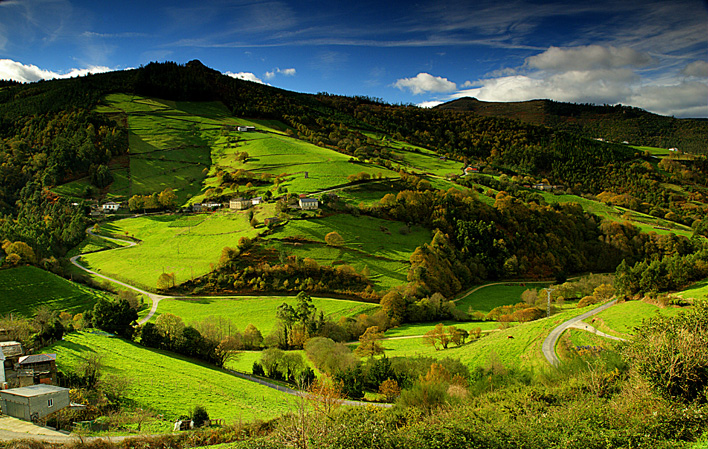

Hiking is possibly the best way to admire these lush spots In Asturias, there are trails suitable for all physical conditions and tastes and for those looking for only short excursions. And you don't even need to park the car. The intricate network of regional motorways allows you to combine visits and organise unforgettable excursions. Other options are cycling along the sign-posted and well-preserved greenways or taking a journey on one of the routes travelled by giant dinosaurs, using their ichnites carved on rocks as a guide.
Wildlife watching tourism has opened up a new door of experiences: set off on an ornithological route, follow the footsteps of the brown bear, get a taste of nature on an excursion collecting plants that are used in cookery workshops or travel through folds used by shepherds keeping your eye on the sky to spot the bearded vulture, reintroduced into Picos de Europa, in flight. This way you will be able to experience the passion for Asturian nature first hand.
 0
Like
Published at 10:27 PM Comments (1)
0
Like
Published at 10:27 PM Comments (1)
Week 2 - Stay at Home
Tuesday, March 24, 2020

Spain began its second week of total lockdown in the worst way possible on Monday. A total of 462 people died due to the coronavirus outbreak in just 24 hours. That’s the biggest daily rise seen up until today and confirms a trend that no expert expects will change in the coming days. “We are still in a phase of growth in the impact of the virus, and this will still last some time,” explains Pere Godoy, president of the Spanish Epidemiology Society.
The number of deaths in Spain caused by the rapid spread of the SARS-CoV-2 virus on Monday reached 2,182, meaning that Spain has taken just three days to double the 1,000 deaths that had been registered on Friday. Not even China or Italy – two of the worst-hit countries in the world during this pandemic – saw that rhythm of fatalities.
What’s more, Spain is seeing a much wider territorial spread of the epidemic compared to Italy. In both cases, around 90% of the first 100 deaths were seen in three regions. In Italy, these were Lombardy, Emilia-Romagna and Veneto. In Spain, the first outbreaks occurred in Madrid, the Basque Country-La Rioja (both were sites of the same outbreak) and Aragón. In Italy, mobility was reduced more when the first outbreaks were detected.
More than 80% of the 6,000 deaths that Italy has seen continue to happen in the same three regions, a percentage that in Spain has fallen to 65%. The reason for this is that unlike Italy – where the rest of the territories continue to see relatively low rates – in Spain there has been a rapid rise in cases in a group of regions. These are Catalonia, Castilla y León and Castilla-La Mancha. To a lesser extent, this rise has also been seen in the Valencia region.
“There is a group of regions that, without reaching the highest rates, have registered a notable increase in deaths in the last week,” explains Daniel López Acuña, an associate professor at the Andalusian School of Public Health and the former director of Health Action in Crisis at the World Health Organization (WHO). “This is a phenomenon that didn’t happen in Italy.
" The expert believes that this was due to the fact that “in Italy, mobility was reduced more when the first outbreaks were detected, while in Spain mobility was very high even during the days ahead of the declaration of the state of alarm.”
While experts believe that it is still early to reach conclusions with scientific evidence, Pere Godoy also points to the moments ahead of the state of alarm. “I think it was a mistake to allow the large geographical dispersion that took place in the days prior to the introduction of isolation, something that could have facilitated the dispersion of the virus.”
Another factor that López Acuña points to is the “trickle of cases imported from Italy that definitely was in Spain in the days prior to the detection of local contagions.” He continues: “These were definitely more intense and disperse than those that could have happened between China and Italy, which explains the current rise observed in these regions.”
Joan Ramon Villalbí, a member and ex-president of the Spanish Public Health and Health Administration Society (SESPAS), believes that the differences between Spain and Italy also have had an influence. “It is likely that as a state, Spain is more integrated into the flow of circulation of persons than Italy, where there are huge differences between the north and the south,” he says.
This would explain, for example, why a region with a high population level such as Sicily, which has more than five million inhabitants, has seen just three deaths from the coronavirus as of Sunday. But it doesn’t explain why another area in Italy, such as Tuscany, with 3.8 million residents, has also seen a much lower impact. This has led the experts to conclude that the causes of the phenomenon are “a combination” of those previously mentioned.
Please stay at home and only leave your house if it is absolutely necessary.
Stay Safe.
[source El Pais]
 0
Like
Published at 3:12 PM Comments (0)
0
Like
Published at 3:12 PM Comments (0)
Spain’s coronavirus deaths soar past 1,000, while infections rise to nearly 20,000
Friday, March 20, 2020
The latest figures from the Health Ministry on Friday put the number of coronavirus infections at 19,988, with 1,141 patients in intensive care and 1,002 dead.
Fernando Simón, the director of the Health Ministry’s Coordination Center for Health Alerts, said that the number of cases had risen by 16.5%, which was “substantially lower” than the 25% spike in infections reported on Thursday.
The health expert, however, warned that the figures may not be an accurate reflection of the local transmission of the virus.
“In some communities, the suspicion is that the local transmission is greater than what is indicated by the figures,” said Simón. “We are not able to report on cases that have not been confirmed, and we don’t have an objective idea of community transmission. Studies are being done to understand the situation. It is very likely that the figures underestimate the total transmission.”
Simón added that the health authorities were doing everything possible to prevent coronavirus fatalities, but that in serious cases “death is a reality.” According to the health expert, 10,542 people have been hospitalized with the coronavirus (52% of the total number of infections), and 1,585 had been cured.
When asked why Germany had a lower fatality rate from the Covid-19, Simón replied: “I cannot explain it ... We are making an effort to understand it, to see whether if it is the reality or if there are discrepancies in the methodology.” As of Friday morning, Germany had 13,957 confirmed cases of coronavirus, but only 31 deaths.
The Madrid region recorded the highest number of cases, with 7,165 patients testing positive for the virus, 44.1% of the total in Spain. As of Friday, the northern Basque Country had 1,465 cases.
Lockdown in Spain
Spanish authorities congratulated citizens on Friday for their efforts in observing the stay-at-home orders issued by the government on Saturday, following the declaration of a state-of alarm that placed the entire country on lockdown.
“Yesterday [on Thursday] I spoke about discipline. I have to congratulate all Spaniards, who have been behaving like soldiers at this time,” said Miguel Ángel Villarroya, the Defense Chief of Staff. “In this strange war, we are all soldiers. Everyone has a role that corresponds to them.”
María José Rallo, the secretary-general of the Transportation Ministry, said that the confinement orders were being respected, noting that occupancy had fallen to 14% on the intercity train line Cercanias, with respect to a normal day, and to 2% for medium and long-distance train services.
The joint operational director of the National Police, José Ángel González, warned, however, that the number of arrests for disobeying the state of alarm was on the rise. Since the decree came into effect, 157 people have been arrested for breaching the restrictions on movement. “We are going to increase the number of patrols at transportation hubs to avoid crowds. We will strengthen the surveillance of the exits and entry points into other cities,” he said.
Simón added that “we are coming up to a week since the implementation of the decree. The most difficult days that must be endured are upon us.”
[source El Pais]
 2
Like
Published at 7:45 PM Comments (4)
2
Like
Published at 7:45 PM Comments (4)
LOCKDOWN UPDATE: Key measures that are NOW in place
Monday, March 16, 2020
The decree approved by the government on Saturday has immediately locked down the country, limiting the movement of citizens across the entire territory

Why has the state of alarm been implemented?
To deal with the health situation caused by the SARS-CoV-2 coronavirus. According to Article 116.2 of the Spanish Constitution, the state of alarm can be declared “in all or part of the national territory, when there are health crises that involve serious alterations to normality.”
Which parts of Spain do the measures affect?
The declaration of the state of alarm went into action on Saturday night and affects the whole of Spain for a period of 15 days.
Which branch of the administration is in charge?
Under the state of alarm, the central government in Madrid has all powers. All security forces, including local and regional police forces, are under direct orders of Interior Minister Fernando Grande-Marlaska. The government will reserve the right to fine people who do not respect the restrictions, as is allowed under the 1981 law setting out the conditions of the state of alert.
What are the restrictions on movement?
# During the state of alarm, citizens and vehicles will only be allowed to travel on public roads and streets for the following activities:
# The purchase of foodstuffs, pharmaceuticals and essential items - always alone unless you need assistance because of age or disability.
# To attend health centres.
# To go to work or to provide employment services - travelling alone in the car at all times.
# To return to your usual residence.
# To assist and care for seniors, minors, dependants, the disabled, or people who are particularly vulnerable.
# In cases of force majeure or of necessity - (eg. You can walk your dog, but alone and close to home)
# Any other activity that is, by its nature, justified.
# Vehicles may take to the roads for any of the aforementioned activities, as well as to refuel at gas stations.
# Limits to commercial activity, restaurants and leisure centres
# All premises and establishments that carry out public-facing activity are closed, apart from those distributing foodstuffs and essential items.
# Cafés and restaurants are shut, but they will be able to deliver food to people’s homes.
# Public shows such as cinemas and theatres are closed, as well as sporting events, museums, etc.
# All local fiestas and marches are suspended.
Ceremonies and religious sites
Civil and religious ceremonies, and services in places of worship, including funerals, can go ahead provided that there are no large crowds and that attendees maintain a distance of one meter from one another.
Reinforcements for the health system
Military personnel and health installations will be used to strengthen the national health system across Spain. The Health Ministry will ensure that production centres for health supplies continue to operate, including the temporary intervention of companies, private health establishments and pharmaceutical sector centres.
How will transport and supplies be regulated?
Rail and bus services can be reduced by 50% by operating companies. The authorities will guarantee the circulation of goods across all of Spain. The supply of tickets for travel available for reservation will be reduced by a third. The government will guarantee the supply of electricity, gas and oil, and the protection of infrastructure that is critical to services.
Is the supply of foodstuffs guaranteed?
The authorities guarantee the production, storage, transport and distribution of foodstuffs to the consumer. When necessary, the transport of produce will be under escort, and routes will be established to allow for the circulation of personnel, raw materials and finished products. To guarantee these supplies, the government has powers to mobilise the state security forces and the army.
Members of the public face fines or even prison if they disobey lockdown rules.
Minumum fine €100 - Maximum fine €600,000
[source El Pais]
 1
Like
Published at 11:36 AM Comments (2)
1
Like
Published at 11:36 AM Comments (2)
Spam post or Abuse? Please let us know
|
|